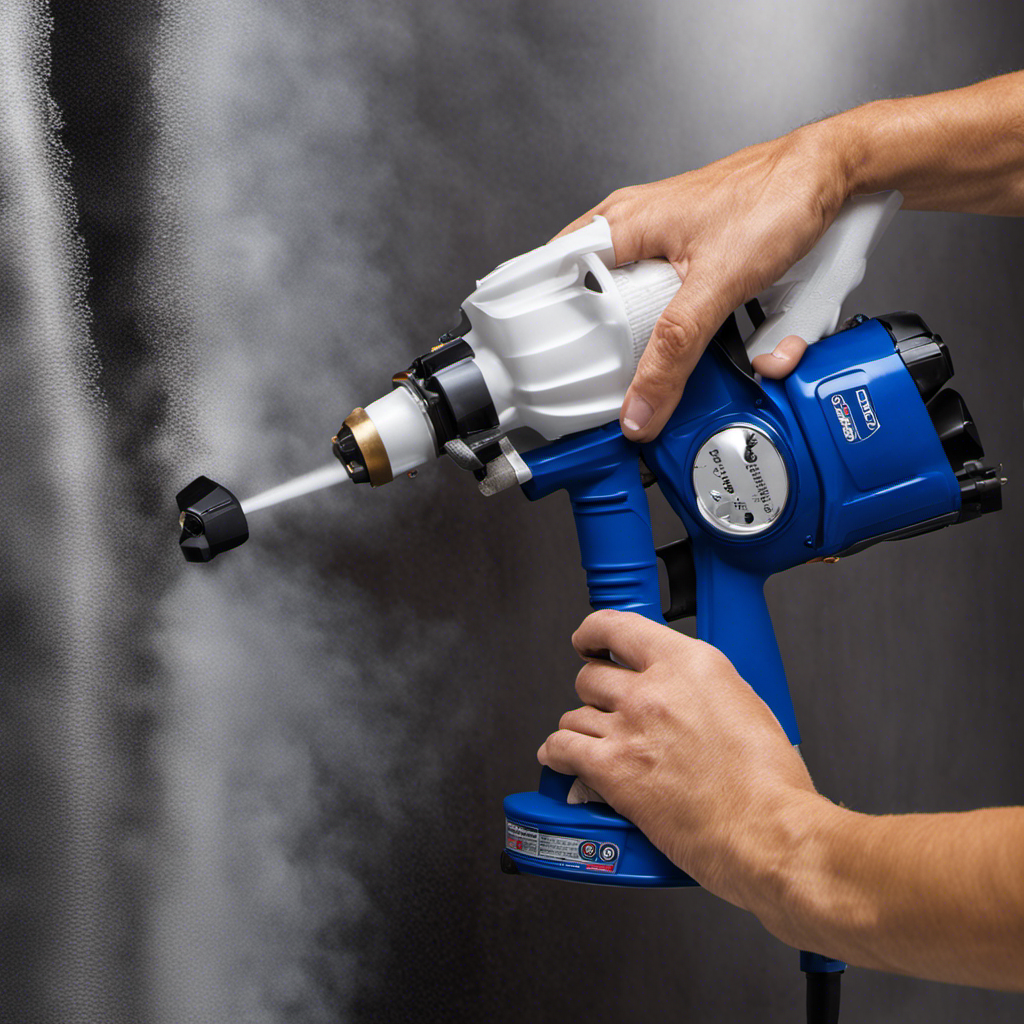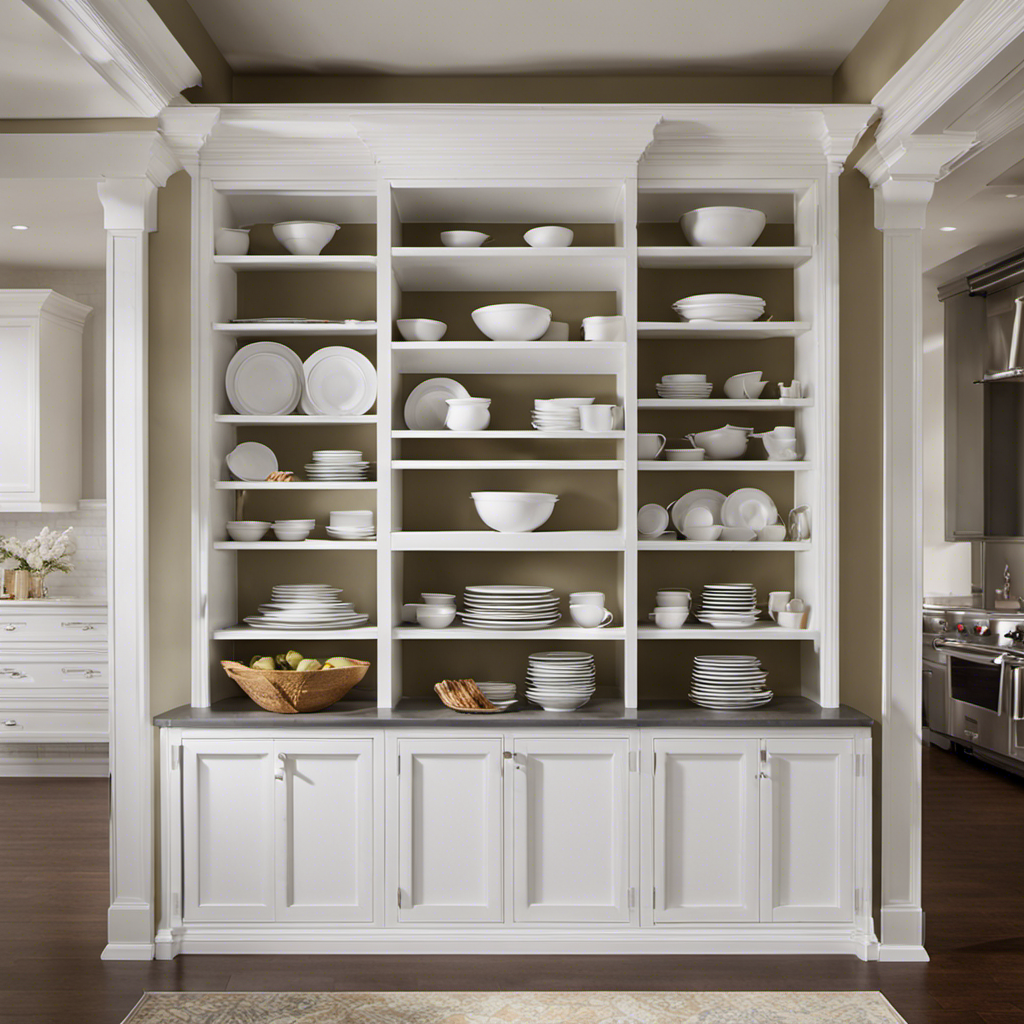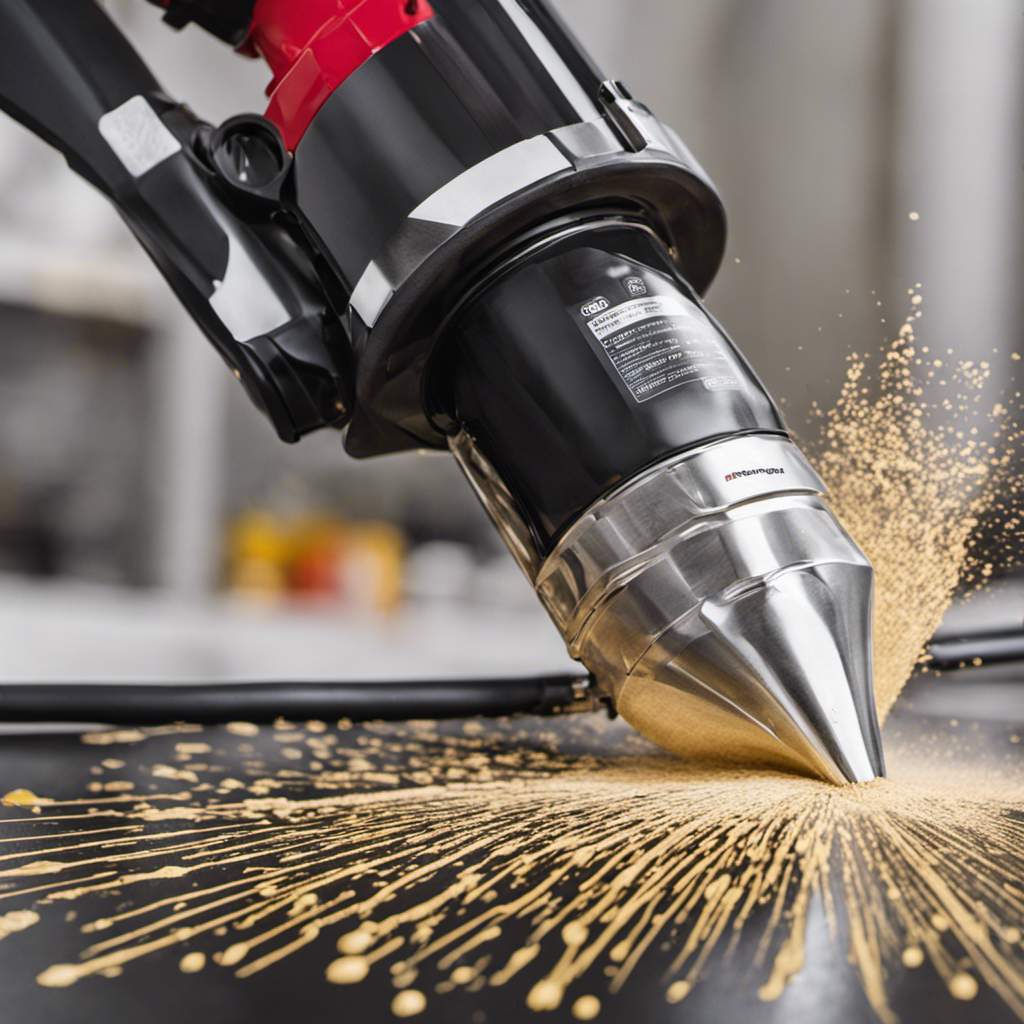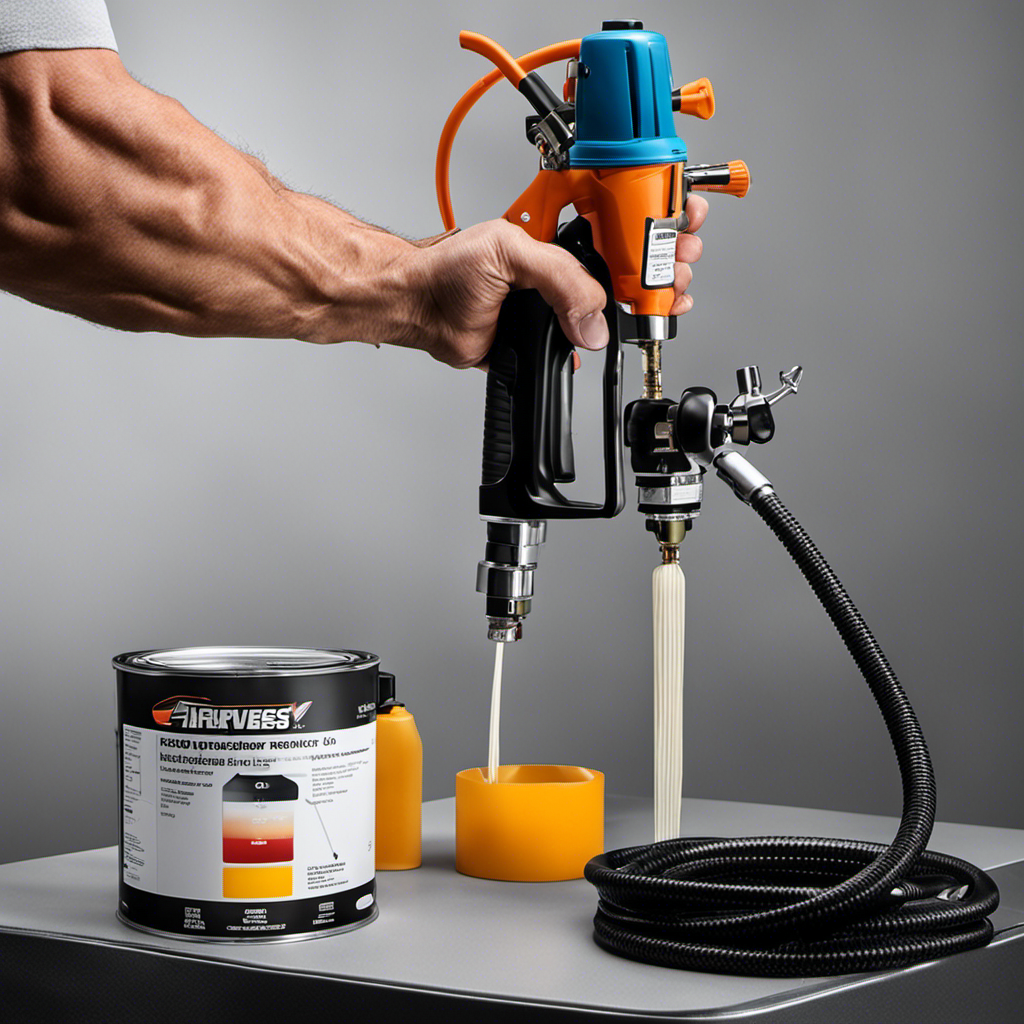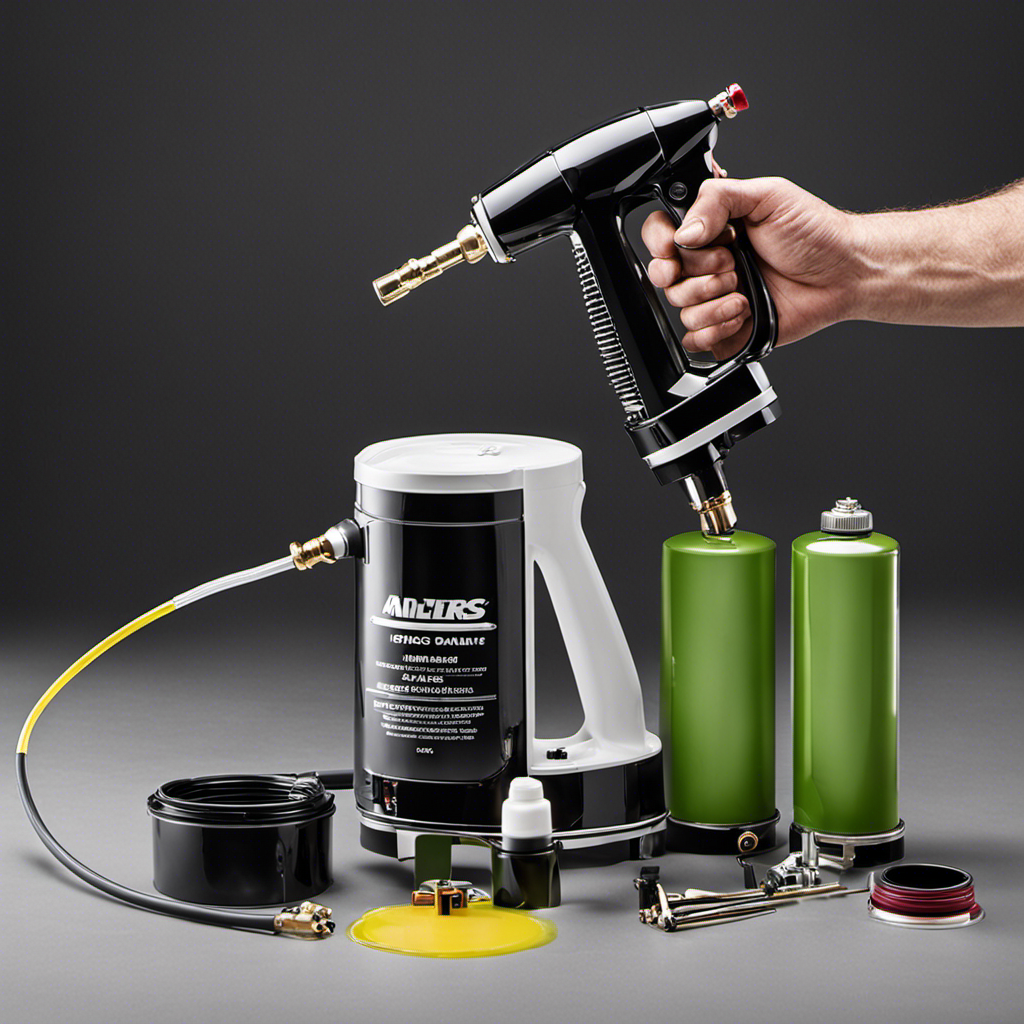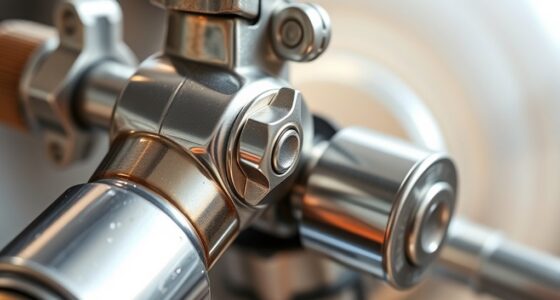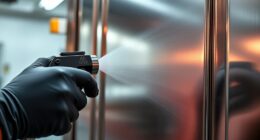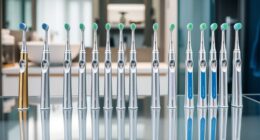As a seasoned painting professional, I have faced numerous difficulties in keeping my equipment in top-notch condition, especially when it comes to maintenance and repairs. One common task that I frequently deal with is extracting valves from a Graco airless paint sprayer.
This seemingly simple procedure can quickly become frustrating if not done correctly. That’s why I’ve put together this step-by-step guide to help you navigate the process with ease.
In just a few simple steps, you’ll be able to remove and clean the valves, ensuring optimal performance and longevity for your sprayer.
Key Takeaways
- Disconnect the power source and drain the paint from the system before removing the valves
- Wear appropriate personal protective equipment and use the necessary tools such as wrenches and pliers for secure removal of the valves
- Clean and inspect the spray tip and guard, replacing them if necessary
- Remove the valve housing cover and inspect the valves for any issues or problems, troubleshooting and addressing them as needed.
Tools Required for Valve Removal
You’ll need a few tools to remove the valves in your Graco airless paint sprayer. Valve removal techniques can vary depending on the specific model, but there are some common tools that will come in handy.
First, you’ll need an adjustable wrench to loosen and remove any nuts or bolts holding the valves in place. Additionally, a pair of pliers will be useful for gripping and twisting any stubborn components. A small screwdriver will also be necessary for prying open any clips or covers that may be securing the valves.
Troubleshooting valve removal can be tricky, so having a flashlight on hand will help you see any hidden parts or potential obstacles. With these tools ready, you can start preparing the airless paint sprayer for valve removal by following the next steps.
Preparing the Airless Paint Sprayer for Valve Removal
To get ready for removing the valves on the Graco airless paint sprayer, make sure to follow these steps.
First, disconnect the power source and ensure that the sprayer is completely turned off. This is crucial for safety reasons and to prevent any accidental spraying.
Next, drain the paint from the system by releasing the pressure and opening the drain valve. This will allow any remaining paint to flow out and prevent any potential mess or clogging during the valve removal process.
Once the power is disconnected and the paint is drained, you can proceed with confidence to the first step of valve removal. It is important to take these precautions to ensure a smooth and successful valve removal process.
Step 1: Disconnecting the Power Source
Before we proceed with disconnecting the power source, it’s important to prioritize safety precautions to prevent any accidents or injuries.
This includes:
- Wearing appropriate personal protective equipment such as gloves and safety glasses.
- Ensuring the power is switched off and the plug is removed from the outlet.
- Verifying that the equipment is depressurized.
Once safety measures are in place, it’s essential to have the proper tools for disconnection, such as a wrench or pliers, to ensure a secure and efficient removal process.
Safety Precautions for Disconnecting
Make sure you’re wearing protective gloves and goggles when disconnecting the valves on your Graco airless paint sprayer. Safety precautions are crucial to prevent any accidents or injuries during the valve removal process. Here are some key points to keep in mind:
- Always switch off the power and unplug the sprayer before attempting any valve removal.
- Release the pressure from the system by triggering the gun until no more paint comes out.
- Use a wrench or pliers to carefully loosen the valve connection, taking care not to apply excessive force.
- Once the valve is disconnected, inspect it for any damage or wear and replace if necessary.
By following these safety precautions and valve removal techniques, you can ensure a smooth and secure disconnection process.
Now, let’s move on to discussing the proper tools for disconnection without any further delay.
Proper Tools for Disconnection
Using the right tools is essential for a safe and efficient disconnection process. When disconnecting valves in a Graco airless paint sprayer, it is important to have the proper tools to ensure a smooth and hassle-free experience. Here are three essential tools that will aid in the disconnection process:
| Tool | Purpose | Safety Precautions |
|---|---|---|
| Adjustable Wrench | Used to loosen and tighten connections | Always wear safety gloves and goggles |
| Needle Nose Pliers | Helps grip and remove small components | Ensure the sprayer is turned off |
| Screwdriver | Used to remove screws and fasteners | Disconnect from power source before use |
Step 2: Draining the Paint From the Sprayer
Once you’ve finished painting, start by disconnecting the sprayer from the power source. Safety is crucial, so always follow the proper steps to avoid any accidents. Here are a few techniques and methods for draining the paint from the sprayer:
-
Flush the System: Run water or solvent through the sprayer until the paint is fully flushed out.
-
Use a Bucket: Place a bucket under the spray gun and trigger it to release any remaining paint.
-
Dispose of Paint Properly: Follow local regulations for paint disposal. Empty cans can be recycled, while leftover paint can be taken to a hazardous waste facility.
-
Clean the Filters: Remove and clean the filters to ensure optimal performance for your next painting job.
Now that the paint is drained, let’s move on to the next step: removing the spray tip and guard.
Step 3: Removing the Spray Tip and Guard
To continue with the next step, start by disconnecting the sprayer from the power source and take off the spray tip and guard.
Proper maintenance of the spray tip is crucial for optimal performance of your Graco airless paint sprayer. It is recommended to clean the spray tip after each use to prevent clogging and ensure a smooth paint flow. If the spray tip becomes worn or damaged, it should be replaced to avoid any issues during your painting projects.
Similarly, the guard plays a vital role in protecting the spray tip and preventing accidental damage. If the guard shows signs of wear or cracks, it is important to replace it promptly.
By regularly inspecting and maintaining the spray tip and guard, you can ensure the longevity and efficiency of your paint sprayer.
Now, let’s move on to step 4: accessing the valve housing, where we will delve into the process of removing the valves in your Graco airless paint sprayer.
Step 4: Accessing the Valve Housing
Now that we have successfully removed the spray tip and guard, it’s time to move on to the next step in removing valves in a Graco airless paint sprayer.
In this step, we will be accessing the valve housing to troubleshoot and address any valve problems that may be present.
To access the valve components, follow these steps:
- Locate the valve housing, which is typically located near the pump area.
- Use a screwdriver to remove the screws securing the valve housing cover.
- Carefully lift off the valve housing cover to reveal the inner components.
- Take note of the position and arrangement of the valves for later reassembly.
By accessing the valve housing, we are now ready to troubleshoot and address any valve problems that may be causing issues with the paint sprayer. This step is crucial in ensuring the proper functioning of the valves and maintaining optimal performance.
Now, let’s move on to the next section, where we will discuss step 5: removing the valve housing cover.
Step 5: Removing the Valve Housing Cover
After removing the screws, carefully lift off the cover of the valve housing to reveal the inner components. The valve housing is a crucial part of the airless paint sprayer and it requires regular maintenance to ensure its optimal performance. Troubleshooting issues with the valve housing can often be resolved by inspecting and cleaning the internal parts. Here is a table outlining common valve housing problems and their possible solutions:
| Problem | Possible Solution |
|---|---|
| Leaking from the housing | Check for loose fittings and tighten them |
| Restricted flow | Clean the housing and remove any debris |
| Stuck valve | Lubricate the valve and ensure smooth movement |
Proper maintenance of the valve housing is essential for the smooth operation of the paint sprayer. By regularly inspecting and cleaning the housing, you can prevent any potential issues and ensure the longevity of your equipment. Now, let’s move on to the next step of removing the valve assembly.
Step 6: Removing the Valve Assembly
When you’re ready, carefully detach the assembly to access the inner workings of the valve. Before proceeding, make sure you have the necessary tools: a wrench, pliers, and a screwdriver.
Here are four crucial steps to remove the valve assembly:
- Use the wrench to loosen the nut connecting the assembly to the pump.
- Gently pull the assembly out of the housing cover, making sure not to damage any surrounding components.
- Inspect the assembly for any signs of wear or damage, such as cracks or excessive buildup.
- If troubleshooting valve problems, pay particular attention to the o-rings and seals for any signs of leakage.
Now, with the valve assembly removed, we can move on to the next step: inspecting and cleaning the valve components to ensure optimal performance.
Step 7: Inspecting and Cleaning the Valve Components
Valve maintenance is a crucial aspect of ensuring the proper functioning of any system. In this discussion, I will be covering some valuable valve maintenance tips, common valve issues that may arise, and effective cleaning techniques for valves.
Valve Maintenance Tips
To keep your valves in optimal condition, make sure you regularly clean and lubricate them. Maintaining your valves is crucial for the proper functioning of your equipment. Here are some valve maintenance tips to help you troubleshoot and prevent valve issues:
- Inspect the valves regularly for any signs of wear or damage.
- Clean the valves thoroughly using a gentle cleaning solution and a soft brush.
- Lubricate the valves with a suitable lubricant to ensure smooth operation.
- If you encounter persistent valve problems, consider replacing the valves with new ones to maintain optimal performance.
By following these maintenance tips, you can prevent valve issues and ensure the longevity of your equipment.
However, even with regular maintenance, valves can still encounter common issues that require further troubleshooting. Let’s explore these issues in the next section.
Common Valve Issues
One of the most common issues with valves is that they can become clogged over time. This can lead to a decrease in performance and even cause the valve to malfunction.
When troubleshooting valve problems, there are a few common issues to look out for. First, check for any obvious signs of clogging, such as debris or paint buildup. If this is the case, you can try cleaning the valve using specific techniques, which will be discussed in the next section.
Another common valve problem is a leak, which can be caused by worn out seals or a faulty valve stem. In such cases, replacing the necessary parts will solve the issue.
Transitioning into the subsequent section about cleaning techniques for valves, it is important to understand the proper steps to take in order to maintain optimal valve performance.
Cleaning Techniques for Valves
When troubleshooting valve issues, it is important to check for signs of clogging or leaks to maintain optimal performance. Here are some cleaning techniques and troubleshooting tips to ensure that your valves are clean and functioning properly:
- Use a small brush to remove any debris or paint buildup from the valve components.
- Soak the valves in a cleaning solution specifically designed for paint sprayers to dissolve any stubborn residue.
- Rinse the valves thoroughly with clean water to remove any remaining cleaning solution.
- Inspect the valves for any signs of damage or wear, such as cracks or worn seals.
By following these cleaning techniques and troubleshooting tips, you can keep your valves in excellent condition and prevent any potential issues.
Now, let’s move on to the next section and learn how to reassemble the valve housing to complete the maintenance process.
Step 8: Reassembling the Valve Housing
Next, you’ll need to carefully place the valve housing back onto the paint sprayer. This step is crucial for proper valve housing maintenance and troubleshooting valve assembly.
Start by aligning the housing with the corresponding holes on the sprayer body. Make sure the gasket is in place to ensure a tight seal. Gently press the housing down and secure it with the screws provided. Be careful not to overtighten the screws, as this could damage the housing or affect the valve’s operation.
Once the housing is securely in place, you can move on to the next step: testing the valve operation. This will ensure that the reassembled valve is functioning correctly and ready for use.
Step 9: Testing the Valve Operation
After reassembling the valve housing, the next step in maintaining a Graco airless paint sprayer is to test the valve operation. This is an essential part of the troubleshooting process and will help determine if the valve replacement was successful.
To test the valve operation, follow these steps:
- Ensure that the sprayer is properly connected to a power source and that the paint container is filled.
- Turn on the sprayer and activate the trigger to start the paint flow.
- Observe the valve operation closely for any signs of leakage, irregularities, or unusual sounds.
- Test the sprayer with different pressure settings to ensure the valve is functioning correctly in all conditions.
Frequently Asked Questions
Can I Remove the Valves Without Disconnecting the Power Source?
No, it is not safe to remove the valves without disconnecting the power source. Removing valves should only be done after disconnecting the power to avoid any potential electrical hazards and ensure your safety.
How Do I Know if the Valve Assembly Needs to Be Replaced?
To determine if the valve assembly needs replacement, check for signs of failure like leaks, inconsistent pressure, or difficulty priming. Maintaining the valve assembly is crucial for proper functioning of the Graco Airless Paint Sprayer.
What Should I Do if the Valve Components Are Damaged or Worn Out?
If the valve components in my Graco Airless Paint Sprayer are damaged or worn out, I would first assess the extent of the damage. Then, I would consult the product manual for instructions on repairing valves or finding replacement parts.
Is It Necessary to Clean the Valve Components Before Reassembling?
Before reassembling, it is crucial to clean the valve components for proper valve maintenance. Like a surgeon sterilizing tools, the cleaning process ensures optimal performance and prevents issues caused by dirt or debris.
How Often Should I Test the Valve Operation After Reassembling?
After reassembling, I test the valve operation frequently to ensure it’s working properly. If any issues arise, I follow troubleshooting steps to identify and resolve the problem. Maintaining a regular testing frequency helps prevent future complications.
Conclusion
Well, folks, we’ve reached the end of our journey on how to remove valves in a Graco airless paint sprayer.
I hope you’ve enjoyed this thrilling adventure into the world of valve removal. Remember, it’s not just about taking out valves. It’s about disconnecting power sources, draining paint, removing spray tips and guards, inspecting and cleaning valve components, reassembling housing, and testing valve operation.
So, grab your tools and get ready for some valve-removing action! Just be sure to approach it with the technical precision and detail it requires.
Happy valve removal!
Drenched in creativity and armed with a fountain pen, Isolde weaves words as gracefully as a painter strokes their canvas. A writer for Paint Sprayer Zone, her passion for colors, textures, and spaces finds a harmonious blend with her profound knowledge of painting tools and techniques.
Having grown up in a family of artists, Isolde’s tryst with paints began early. While her relatives expressed themselves on canvas, Isolde found her medium in words. She dedicated herself to chronicling the world of painting, understanding the nuances of each tool, and the artistry behind every spritz of a paint sprayer.
